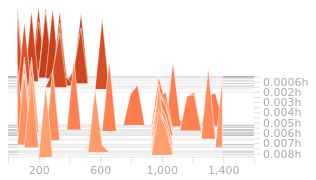While intelligent creatures can explore their environments and learn useful skills without supervision, many RL algorithms are heavily on the basis that acquiring skills is only achieved via defining them as explicit reward functions to learn.
Thus, in order to translate the natural behavior of creatures in learning diverse skills to a suitable mathematical formulation, DIAYN (Diversity is All You Need) was proposed for learning useful skills without any domain-specific reward function.
Instead of the real reward of the environment, DIAYN optimizes the following objective:
that z is the skill that the agent is learning and, since we desire learned skills to be as diverse as possible, z is modeled by a Uniform random variable that has the highest standard variation.
The above equation simply implies that the reward of any diverse task is equal to measuring how hard recognizing the skill z is, given the state s that the agent has visited compared to the real distribution over z (which is Uniform distribution in DIAYN paper.)
The bigger rz(s, a) is, the more ambiguous skill z is thus, the state s should be visited more for task z so, the agent finally acquires this skill.
Concurrently to learn rz(s, a), any conventional RL method can be utilized to learn a policy and DIAYN uses SAC.
This repository is a PyTorch implementation of Diversity is All You Need and the SAC part of the code is based on this repo.
x-axis in all of the corresponding plots in this section are counted by number episode.
number of skills = 20
| similar to the environment's goal | Emergent behavior | Emergent behavior |
|---|---|---|
 |
 |
 |
| Reward distribution | Reward distribution | Reward distribution |
 |
 |
 |
number of skills = 50
| similar to the environment's goal | Emergent behavior | Emergent behavior |
|---|---|---|
 |
 |
 |
| Reward distribution | Reward distribution | Reward distribution |
 |
 |
 |
number of skills = 20
| similar to the environment's goal | Emergent behavior | Emergent behavior |
|---|---|---|
 |
 |
 |
| Reward distribution | Reward distribution | Reward distribution |
 |
 |
 |
- gym == 0.17.3
- mujoco-py == 2.0.2.13
- numpy == 1.19.2
- opencv_contrib_python == 4.4.0.44
- psutil == 5.5.1
- torch == 1.6.0
- tqdm == 4.50.0
pip3 install -r requirements.txt- Note, this way maybe not work. On my server, I use:
- download the mujoco210, unzip the file, and write down the PATH in the .bashrc
- git down the mujoco-py source code, and
python setup.py install pip install gym==0.17.3- (maybe useful)
pip install opencv-python==4.3.0.38,pip install box2d box2d-kengz,apt-get install -y patchelf - the other packages are not difficult to install, don't care about the edition
usage: main.py [-h] [--env_name ENV_NAME] [--interval INTERVAL] [--do_train]
[--train_from_scratch] [--mem_size MEM_SIZE]
[--n_skills N_SKILLS] [--reward_scale REWARD_SCALE]
[--seed SEED]
Variable parameters based on the configuration of the machine or user's choice
optional arguments:
-h, --help show this help message and exit
--env_name ENV_NAME Name of the environment.
--interval INTERVAL The interval specifies how often different parameters
should be saved and printed, counted by episodes.
--do_train The flag determines whether to train the agent or play
with it.
--train_from_scratch The flag determines whether to train from scratch or
continue previous tries.
--mem_size MEM_SIZE The memory size.
--n_skills N_SKILLS The number of skills to learn.
--reward_scale REWARD_SCALE The reward scaling factor introduced in SAC.
--seed SEED The randomness' seed for torch, numpy, random & gym[env].- In order to train the agent with default arguments , execute the following command and use
--do_trainflag, otherwise the agent would be tested (You may change the memory capacity, the environment and number of skills to learn based on your desire.):
python3 main.py --mem_size=1000000 --env_name="Hopper-v3" --interval=100 --do_train --n_skills=20- If you want to keep training your previous run, execute the followoing:
python3 main.py --mem_size=1000000 --env_name="Hopper-v3" --interval=100 --do_train --n_skills=20 --train_from_scratch- When I tried to keep training from checkpoints to continue my previous run, I observed some undesirable behavior from the discriminator that its loss rapidly converged towards 0 however, after some epochs it again returned to its correct previous training phase. I suspect since at the beginning of training from checkpoints the replay memory is empty and familiar experiences (according to the policy) gradually get added to it, the trained discriminator from the previous run can easily recognize their true skills until the replay memory gets populated big enough and contains newer and more novel transitions. Thus, I recommend running your whole training monotonically and avoid using checkpoints and successive pausing though, it is been provided.
- Hopper-v3
- bipedalWalker-v3
- MountainCarContinuous-v0
- HalfCheetah-v3
├── Brain
│ ├── agent.py
│ ├── __init__.py
│ ├── model.py
│ └── replay_memory.py
├── Checkpoints
│ ├── BipedalWalker
│ │ └── params.pth
│ ├── Hopper
│ │ └── params.pth
│ └── MountainCar
│ └── params.pth
├── Common
│ ├── config.py
│ ├── __init__.py
│ ├── logger.py
│ └── play.py
├── Gifs
│ ├── BipedalWalker
│ │ ├── skill11.gif
│ │ ├── skill40.gif
│ │ └── skill7.gif
│ ├── Hopper
│ │ ├── skill2.gif
│ │ ├── skill8.gif
│ │ └── skill9.gif
│ └── MountainCar
│ ├── skill3.gif
│ ├── skill7.gif
│ └── skill8.gif
├── LICENSE
├── main.py
├── README.md
├── requirements.txt
└── Results
├── BipedalWalker
│ ├── running_logq.png
│ ├── skill11.png
│ ├── skill40.png
│ └── skill7.png
├── equation.png
├── Hopper
│ ├── running_logq.png
│ ├── skill2.png
│ ├── skill8.png
│ └── skill9.png
├── MountainCar
│ ├── running_logq.png
│ ├── skill3.png
│ ├── skill7.png
│ └── skill8.png
└── r_z.png- Brain dir consists of the neural network structure and the agent decision-making core.
- Common consists of minor codes that are common for most RL codes and do auxiliary tasks like logging and... .
- main.py is the core module of the code that manages all other parts and makes the agent interact with the environment.
Big thanks to:
- @ben-eysenbach for sac.
- @p-christ for DIAYN.py.
- @johnlime for RlkitExtension.
- @Dolokhow for rl-algos-tf2 .
这个库完成还算可以,目前还没有与论文仔细比对,单从运行情况,是可以训练以及评估模型,并且可视化生成视频也没有问题。
- 因为服务器没有外接显示器,所以需要虚拟运行(评估时),我们通过
xvfb虚拟出一个图形界面,如果没有这个库,可以通过apt-get install xvfb安装
xvfb-run -s "-screen 0 1400x900x24" python3 main.py --mem_size=1000000 --env_name="MountainCarContinuous-v0" --interval=100 --n_skills=20
- 在评估时,由于
env.render(mode='rgb_array')带有参数,目的是拿到图片,所以要注释掉libGLEW.so, 而训练时state = env.reset()直接获取的状态空间向量,并不是图像像素。这个时候可以加上libGLEW.so。但目前还没有尝试过以图像作为输入的算法,设置细节可能还会有变化。
在Hopper-v3环境上使用内置参数,完整训练耗时15个半小时,以下是对比原始模型权重的评估结果
- train
- origin
通过分析20个skill的可视化视频,发现了非常有趣的现象(origin和train都存在)。一些skill在无监督的条件下,学会了 前进 、 后退 、静态平衡 、 动态平衡 、 踮脚站立 、 前倾摔倒 等等,这些都可能成为下游任务的技能,甚至是目标。初步实验,感觉DIAYN是个不错的算法,不过有点耗时。
原始仓库中未完成在HalfCheetah-v3环境上的实验,这里借此训练任务,顺带测试下两台服务器的训练速度。由于目前是单线程的训练模式,慢得接受不了,随后会进行多进程训练的改进。这里测试的两台GPU分别是A100和V100,其实都没有满载,显存占用也非常低。主要测试对比单核性能以及pytorch1.8.0与pytorch1.8.1以及pytorch1.6.0的效率(PS:因为曾用过一次1.8.1带来了不好的体验,然而这次显卡底层驱动只支持到CUDA10.1,别无选择,若1.8.1性能不及1.6.0,则可以回滚版本)
跟踪服务器运行状态,V100服务器的CPU性能更好,给训练效率带来了一点点提升,但无关痛痒,所以问题还是单进程太慢。另外这台服务器上对比的pytorch1.8.1与pytorch1.6.0在速度上接近,1.8.1快一丢丢,但二者在CPU占用率和显存占用率上有差别,1.6.0CPU占用率更高,显存占用率低一点,GPU利用率二者相当。





